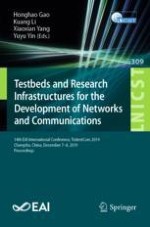2020 | Book
Testbeds and Research Infrastructures for the Development of Networks and Communications
14th EAI International Conference, TridentCom 2019, Changsha, China, December 7-8, 2019, Proceedings
Editors: Honghao Gao, Kuang Li, Xiaoxian Yang, Yuyu Yin
Publisher: Springer International Publishing
Book Series : Lecture Notes of the Institute for Computer Sciences, Social Informatics and Telecommunications Engineering
